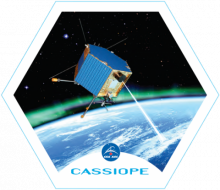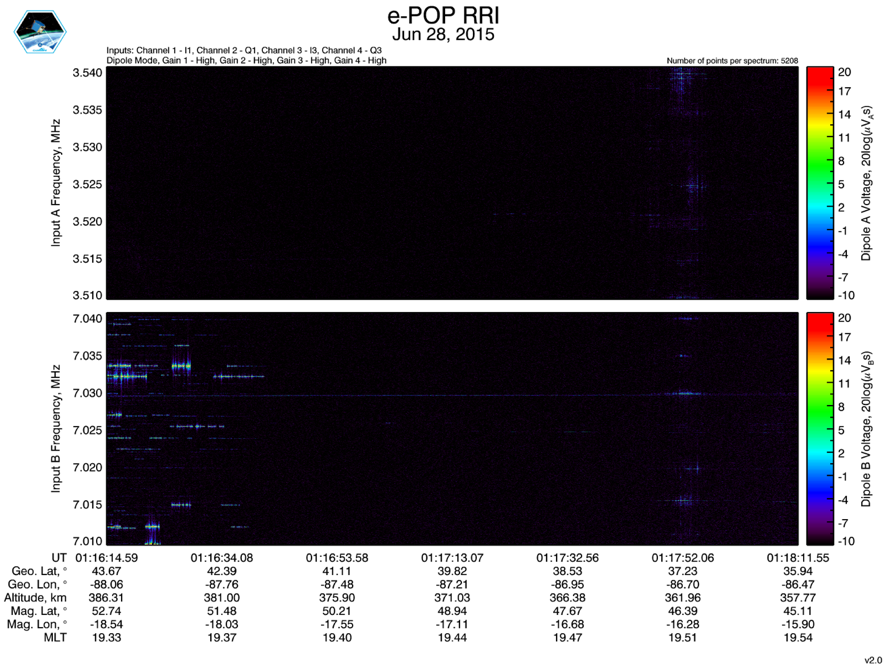e-POP Spacecraft to Participate in 2017 ARRL Field Day
e-POP Spacecraft to Participate in 2017 ARRL Field Day

By G. W. Perry, N. A. Frissell, E. S. Miller, and J. D. Katz
The Enhanced Polar Outflow Probe (e-POP) onboard the Canadian CAScade Smallsat and Ionospheric Polar Explorer (CASSIOPE) satellite will once again be supporting ham radio citizen science by participating in the 2017 American Radio Relay League Field Day, on June 24 and 25, 2017.
On an annual basis, the ham radio community participates in the ARRL Field Day to exercise and hone their skills in the field. In essence, it is an emergency preparedness exercise – one of the largest anywhere – with several thousand hams taking part across the world. From a radio science perspective, Field Day is an ideal time for e-POP to study the structure of the Earth’s ionosphere using Field Day participants’ transmissions.
Launched in September 2013, e-POP is one of two payloads on the CASSIOPE spacecraft; the other is a commercial high-capacity data courier technology demonstration. e-POP is a suite of eight science instruments with an objective of studying the ionosphere and space weather effects. The spacecraft’s mission and science operations are headquartered at the University of Calgary, and its operations are funded by the European Space Agency (ESA). More information about e-POP can be found at https://epop.phys.ucalgary.ca. One of e-POP’s instruments is the Radio Receiver Instrument (RRI), a digital receiver with four 3 m monopole antennas, with a scientific objective of studying natural and artificial radio emissions from 10 Hz to 18 MHz. RRI’s monopoles can be electronically configured into a crossed-dipole setup. RRI has two data channels – one for each dipole. Each channel is sampled at 62.5 kHz, and passed through a 30 kHz bandpass.
During the 2015 ARRL Field Day on June 28, 2015, RRI was activated for two minutes, starting at 1:16 UT, while e-POP was just north of Milwaukee, on a southeasterly heading. RRI was in a crossed-dipole configuration: its two channels were tuned to 3.525 and 7.525 MHz, respectively. A spectrogram (similar to "waterfall display") of the entire 2-minutes of data is shown in Figure 1 (a presentation summarizing the results is available for download). What is most striking about the observations is that, not only are CW ham radio transmissions clearly seen at 40 m (Channel B), but that they are only observed for about the first 30 seconds, even though data from the Reverse Beacon Network (RBN) show that those ham operators continued transmitting throughout the entirety of the experiment.
A science article is currently being prepared by Dr. Gareth Perry and colleagues in the HamSCI community to report the experiment and the characteristics of the received signals. It is not surprising that signals were not received on the 80 m band (Channel A). Those transmissions should – theoretically – not have been able to penetrate the ionosphere and propagate to RRI during the experiment. On the other hand, transmissions on the 40 m band were able to do just that. These signals can be used to study HF radio wave propagation. The advantage of using the ham community’s transmissions is that since each user’s call sign is coded in their call, the source of the signal can be identified. This allows the point of origin of each signal to be identified, input into a HF ray trace model, and then used to the elucidate the properties of the ionosphere during the experiment. During the 2015 Field Day, 23 call signs were identified. The hypothesis that Dr. Perry and colleagues are investigating is that is that the ham signals disappeared as the spacecraft headed south, into latitudes where the ionosphere was denser and blocked the transmissions.

Figure 1: RRI spectrogram from 2015 Field Day activities. Ham radio CW transmissions were only detected on the 40 m band (Channel B, bottom panel) for the first 30 seconds of the experiment. No signals were detected on the 80 m band (Channel A, top panel).
For the 2017 Field Day, e-POP will be dedicating all of its resources to studying HF radio wave propagation using ham radio transmissions. RRI will be once again tuned to the CW bands at 40 and 80 m; however, the exact tuning frequencies have not yet been determined. RRI is scheduled to be activated 6 times, in 10 minute increments, over the Field Day weekend. Below is a table of approximate RRI operations times over Canada and the United Sates. All 2017 Field Day participants are encouraged to transmit on the 40 and 80 m bands during these times.
The results of the 2015 e-POP ARRL Field Day were serendipitous, even if only 2 minutes of data was collected. The data from the upcoming Field Day is sure to offer even further insight into the intricacies of HF radio wave propagation and increase the applicability of citizen radio science in the “traditional” academic radio science methodologies. We’re looking forward to hearing from you!
|
Pass Number |
Date |
Pass Time (UT) |
e-POP altitude (km) |
Pass Direction |
Region |
|
1 |
June 24 |
22:32 – 22:42 |
800 |
NS |
East Coast |
|
2 |
June 25 |
00:13 – 00:23 |
800 |
NS |
Central |
|
3 |
June 25 |
01:54 – 02:04 |
800 |
NS |
West Coast |
|
4 |
June 25 |
11:35 – 11:45 |
1350 |
SN |
East Coast |
|
5 |
June 25 |
13:17 – 13:27 |
1350 |
SN |
Central |
